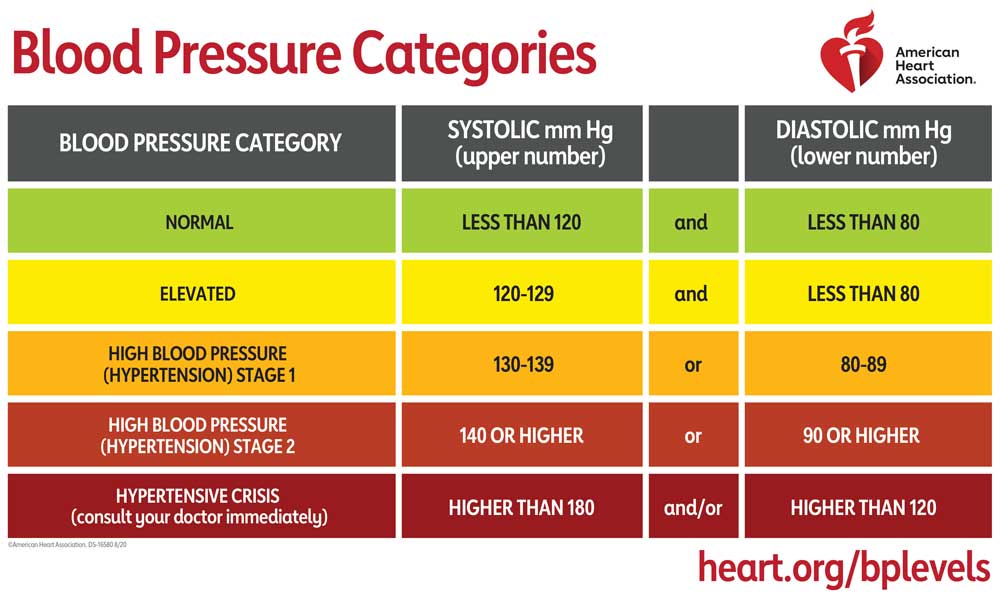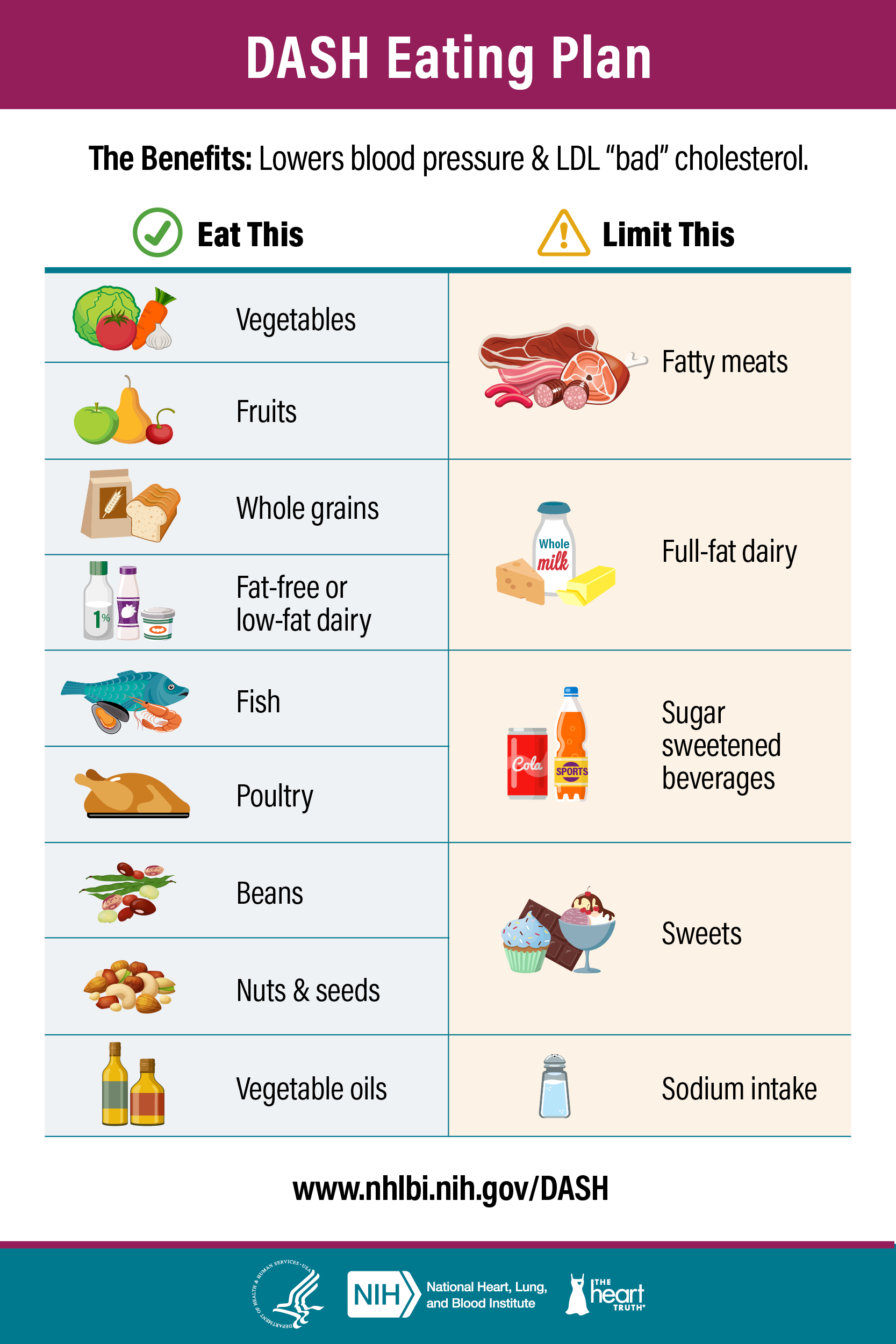Heart Health
Blood Pressure
High blood pressure, or hypertension, occurs when the heart pumps blood too forcefully throughout the body. The more forcefully the blood pumps through the arteries, the more the arteries have to stretch to allow the blood to flow. If the arteries stretch too much, this can cause them to become damaged and become less elastic. This can cause a variety of problems including increasing a person’s risk for having a heart attack or stroke. Therefore, maintaining blood pressure at a healthy level or reducing blood pressure if elevated can be essential to decreasing risks of developing these conditions.
Oftentimes, many people have high blood pressure for years without knowing it, which is why this disease is called a “silent killer.”
There are a variety of factors that can increase a person’s risk for developing this disease, such as genetics, age, gender, overweight or obesity, smoking, high cholesterol, and physical inactivity.
Visit the American Heart Association for more information on High Blood Pressure.
High blood pressure, or hypertension, occurs when the heart pumps blood too forcefully throughout the body. The more forcefully the blood pumps through the arteries, the more the arteries have to stretch to allow the blood to flow. If the arteries stretch too much, this can cause them to become damaged and become less elastic. This can cause a variety of problems including increasing a person’s risk for having a heart attack or stroke. Therefore, maintaining blood pressure at a healthy level or reducing blood pressure if elevated can be essential to decreasing risks of developing these conditions.
Oftentimes, many people have high blood pressure for years without knowing it, which is why this disease is called a “silent killer.”
There are a variety of factors that can increase a person’s risk for developing this disease, such as genetics, age, gender, overweight or obesity, smoking, high cholesterol, and physical inactivity.
Visit the American Heart Association for more information on High Blood Pressure.
Lifestyle Changes to Maintain Normal Blood Pressure and Promote Heart Health or Reduce Blood Pressure
The American Heart Association recommends several lifestyle changes to keep blood pressure at healthy level or reduce blood pressure if is high. Making changes such as quitting smoking, increasing physical activity, and eating a pattern of nutrient rich foods that include plenty of fruits, vegetables, whole grains, lean meats, and low-fat dairy, can be helpful. The Dietary Approaches to Stop Hypertension (DASH) eating pattern has been shown to reduce blood pressure in individuals. Some individuals may require medication in addition to a healthful eating pattern and increased physical activity.
In addition, reducing sodium in eating may help some individuals lower blood pressure. Visit the American Heart Association for more information about sodium in foods. Or check out the USDA’s 10 Tips to Cut Back on Sodium handout.
The American Heart Association recommends several lifestyle changes to keep blood pressure at healthy level or reduce blood pressure if is high. Making changes such as quitting smoking, increasing physical activity, and eating a pattern of nutrient rich foods that include plenty of fruits, vegetables, whole grains, lean meats, and low-fat dairy, can be helpful. The Dietary Approaches to Stop Hypertension (DASH) eating pattern has been shown to reduce blood pressure in individuals. Some individuals may require medication in addition to a healthful eating pattern and increased physical activity.
In addition, reducing sodium in eating may help some individuals lower blood pressure. Visit the American Heart Association for more information about sodium in foods. Or check out the USDA’s 10 Tips to Cut Back on Sodium handout.

Cholesterol
Cholesterol is a fat-like substance that gives structure to the cell in our bodies. Cholesterol levels become a concern if we have too much circulating in our blood, which is a major risk factor for heart disease. There are different types of cholesterol in the body:
HDL cholesterol, high density lipoprotein cholesterol, is also known as “good cholesterol”. Higher levels of HDL cholesterol have been shown to be related to a decreased risk of developing cardiovascular diseases.
LDL cholesterol, low density lipoprotein cholesterol, is known as “bad cholesterol”. LDL cholesterol contributes to the development of plaque in the vessels, making them stiff and less flexible.
The ratio of total cholesterol to HDL cholesterol is the best indicator for the development of heart disease.
Cholesterol is a fat-like substance that gives structure to the cell in our bodies. Cholesterol levels become a concern if we have too much circulating in our blood, which is a major risk factor for heart disease. There are different types of cholesterol in the body:
HDL cholesterol, high density lipoprotein cholesterol, is also known as “good cholesterol”. Higher levels of HDL cholesterol have been shown to be related to a decreased risk of developing cardiovascular diseases.
LDL cholesterol, low density lipoprotein cholesterol, is known as “bad cholesterol”. LDL cholesterol contributes to the development of plaque in the vessels, making them stiff and less flexible.
The ratio of total cholesterol to HDL cholesterol is the best indicator for the development of heart disease.
Eating Healthfully to Reduce the Risk of Heart Disease
Many dietary factors influence the risk of heart disease. Nearly all foods of animal origin contain cholesterol. Dietary cholesterol may increase blood cholesterol levels in some individuals, but not all. However, eating too much fat from any source, especially excessive saturated fat, has been found to increase risk of heart disease. In contrast, diets high in whole grains, vegetables, and fruits are higher in fiber, vitamins, and minerals and can lower the risk of heart disease. For more information, visit the American Heart Association website.
Many dietary factors influence the risk of heart disease. Nearly all foods of animal origin contain cholesterol. Dietary cholesterol may increase blood cholesterol levels in some individuals, but not all. However, eating too much fat from any source, especially excessive saturated fat, has been found to increase risk of heart disease. In contrast, diets high in whole grains, vegetables, and fruits are higher in fiber, vitamins, and minerals and can lower the risk of heart disease. For more information, visit the American Heart Association website.
DASH Diet
DASH (Dietary Approach to Stop Hypertension) Eating Plan is a holistic eating pattern that helps lower high blood pressure. This plan recommends:
Eating vegetables, fruits, and whole grains
Including fat-free or low-fat dairy products, fish, poultry, beans, nuts, and vegetable oils
Limiting foods that are high in saturated fat, such as fatty meats, full-fat dairy products, and tropical oils such as coconut, palm kernel, and palm oils
Limiting sugar-sweetened beverages and sweets
Click here to learn more about the DASH Eating Plan, additional resources, and heart healthy recipes!
DASH (Dietary Approach to Stop Hypertension) Eating Plan is a holistic eating pattern that helps lower high blood pressure. This plan recommends:
Eating vegetables, fruits, and whole grains
Including fat-free or low-fat dairy products, fish, poultry, beans, nuts, and vegetable oils
Limiting foods that are high in saturated fat, such as fatty meats, full-fat dairy products, and tropical oils such as coconut, palm kernel, and palm oils
Limiting sugar-sweetened beverages and sweets
Click here to learn more about the DASH Eating Plan, additional resources, and heart healthy recipes!

Movement
The American Heart Association 150 minutes per week of moderate-intensity aerobic activity or 75 minutes per week of vigorous aerobic activity, or a combination of both, preferably spread throughout the week. Here are some tips to get you started:
Pick activities that you enjoy. Think or write down a list of your favorite ways to get movement. Click here to learn about different ways you can stay active on campus and in the community.
If you typically don’t get a lot of physical activity in your day, start small by only doing 10 minutes every day. Overtime, gradually increase the time and intensity.
If you have a chronic condition or disability, talk with your healthcare provider about what types and amounts of physical activity are right for you before making too many changes.
The American Heart Association 150 minutes per week of moderate-intensity aerobic activity or 75 minutes per week of vigorous aerobic activity, or a combination of both, preferably spread throughout the week. Here are some tips to get you started:
Pick activities that you enjoy. Think or write down a list of your favorite ways to get movement. Click here to learn about different ways you can stay active on campus and in the community.
If you typically don’t get a lot of physical activity in your day, start small by only doing 10 minutes every day. Overtime, gradually increase the time and intensity.
If you have a chronic condition or disability, talk with your healthcare provider about what types and amounts of physical activity are right for you before making too many changes.
